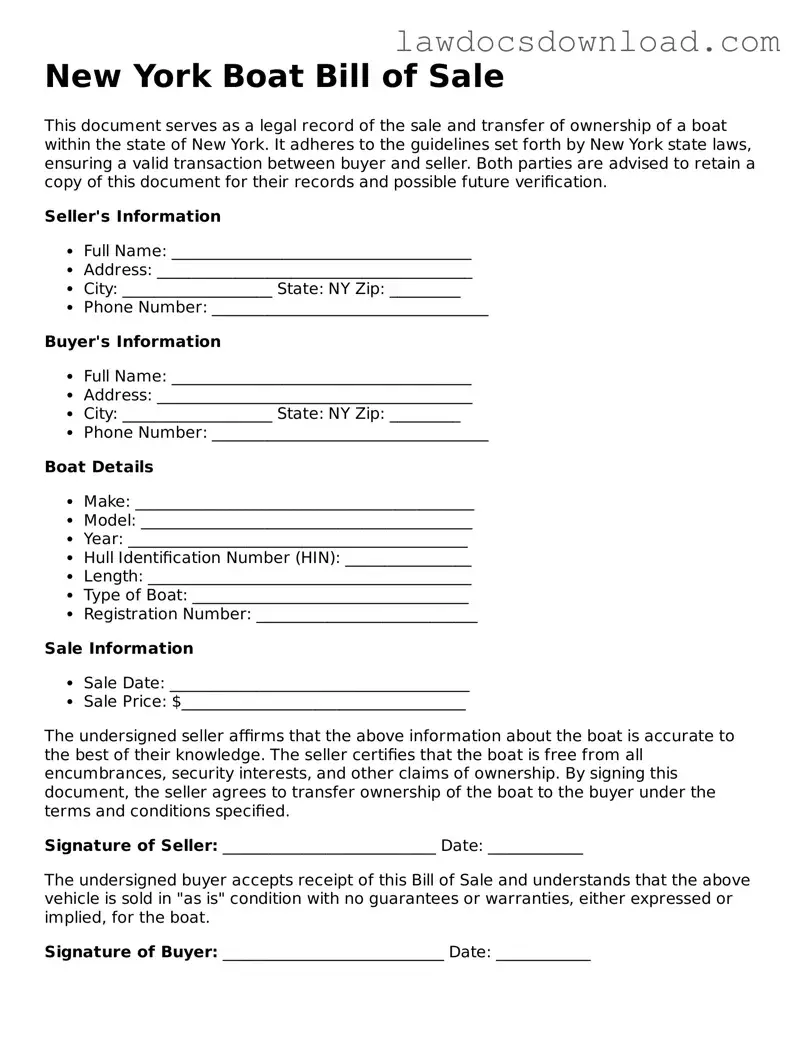The Vehicle Bill of Sale form shares similarities with the New York Boat Bill of Sale in its basic function. Both serve as legal documents to facilitate the transfer of ownership from a seller to a buyer. These forms typically include information like the identification numbers of the vehicle or boat, the sale price, and the names of the parties involved. They act as a receipt for the transaction and may be required for registration purposes.
A General Bill of Sale form is another document akin to the New York Boat Bill of Sale. It is used for transactions involving various items besides vehicles and boats, such as furniture or electronics. Although the items sold might differ, the purpose remains the same: to provide proof of purchase and transfer ownership. This document usually outlines the item's description, the sale amount, and the parties' details.
The Real Estate Bill of Sale is used when transactions involve real property rather than movable assets like boats. Despite this difference, it is similar to the Boat Bill of Sale as it records a transfer of ownership, lists the sale price, and includes the buyer’s and seller's information. This document is crucial for the legal transfer and recording of property ownership.
The Aircraft Bill of Sale form, much like its maritime counterpart, is tailored for the sale of airplanes. It captures specific details pertinent to aircraft, such as the make, model, and serial number, alongside the sale price and parties' details. This document is essential for the registration process and provides legal proof of ownership change.
Firearm Bill of Sale forms also share similarities with the Boat Bill of Sale. They are used to document the sale and transfer of ownership of a firearm. Critical features such as the make, model, and serial number of the firearm, the personal details of the buyer and seller, and the sale price are detailed, mirroring the structure and intent of boat sale documents.
The Business Bill of Sale is analogous to the New York Boat Bill of Sale when a business changes hands. This document outlines the transfer of ownership of business assets, inventory, and sometimes, the entire business entity. It includes information on the sale price and the parties involved, serving as proof of transaction and ownership transfer.
The Equipment Bill of Sale functions similarly to the Boat Bill of Sale, but it focuses on the sale of machinery or equipment. It ensures a documented transfer of ownership, detailing the equipment's description, the transaction's particulars, and the parties' information. This form is essential for both buyer and seller as a record of sale and for potential future registration or warranty claims.
The Livestock Bill of Sale parallels the Boat Bill of Sale in its role during the sale of animals, such as cattle or horses. The documentation includes specifics on the livestock being transferred, the sale price, and the buyer’s and seller's identities. This form is crucial for animal registration purposes and serves as a legal record of the transaction.
Pet Bill of Sale forms are somewhat akin to the New York Boat Bill of Sale, albeit for the sale of pets. These documents include details on the breed, age, and health of the pet, along with the usual particulars of the sale price and the identities of the involved parties. This document serves as a legal proof of transaction and transfer of pet ownership.
Finally, the Art Bill of Sale is related to the Boat Bill of Sale form through its function in transferring ownership of valuable art pieces from one party to another. This document typically includes a detailed description of the artwork, the sale price, and both parties' details. It serves as a crucial record for authenticity, provenance, and for insurance purposes.
